Can You Use HDMI and DisplayPort at the Same Time? to Set Up Dual Monitors
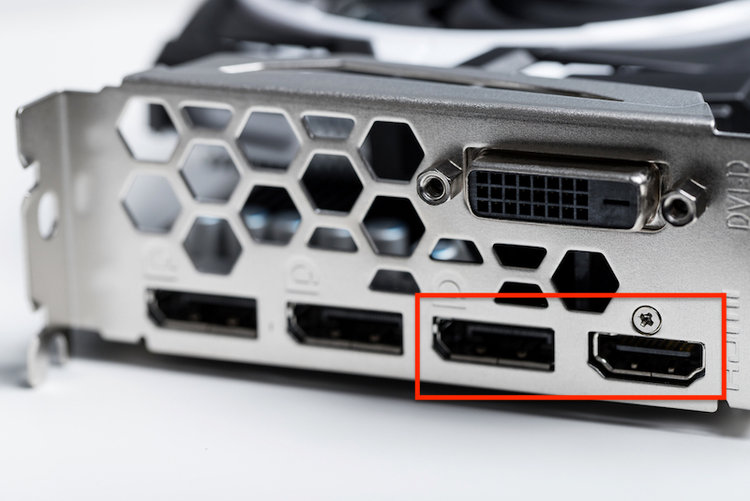
What To Know
- HDMI and DisplayPort can be used simultaneously for dual monitors, but it’s crucial to ensure your GPU and motherboard can handle the graphic load.
- DisplayPort is preferable for high resolutions and fast refresh rates, but HDMI 2.1 offers comparable capabilities, making the choice dependent on port generation and intended use.
- Dual monitors can be set up using a single port through daisy-chaining with DisplayPort 1.2 or above, provided the GPU supports it.
You’ve been wanting a dual-monitor setup for some time, and you’ve finally decided you’re going to splurge and get one.
But then you notice your case only has two output ports: one HDMI and one DisplayPort.
Is it possible to connect dual monitors to your PC with an HDMI and DisplayPort at the same time?
If given a choice, should you use DisplayPort instead of HDMI?
Can you use a single port to set up a dual monitor?
Keep reading to find out!
Quick Navigation
Can You Use HDMI and DisplayPort at the Same Time?
Yes, you can absolutely use an HDMI and DisplayPort at the same time.
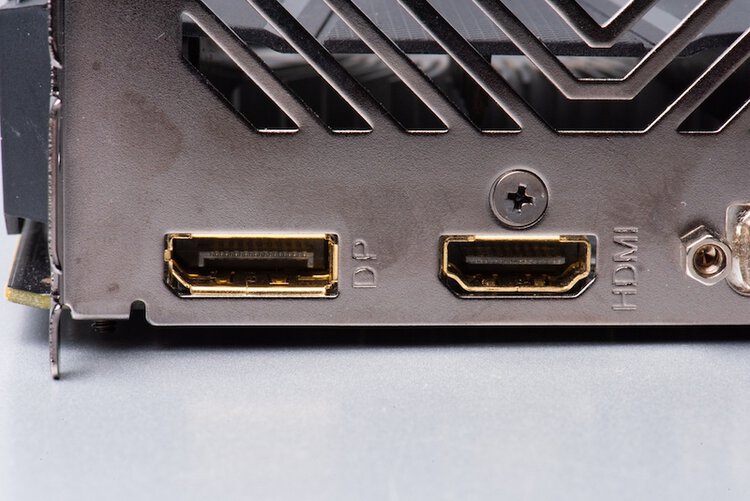
However, you will need to ensure your motherboard or GPU supports a dual monitor setup.
Is It Bad to Use HDMI and DisplayPort at the Same Time?
No, it’s not bad to use HDMI and DisplayPort at the same time.
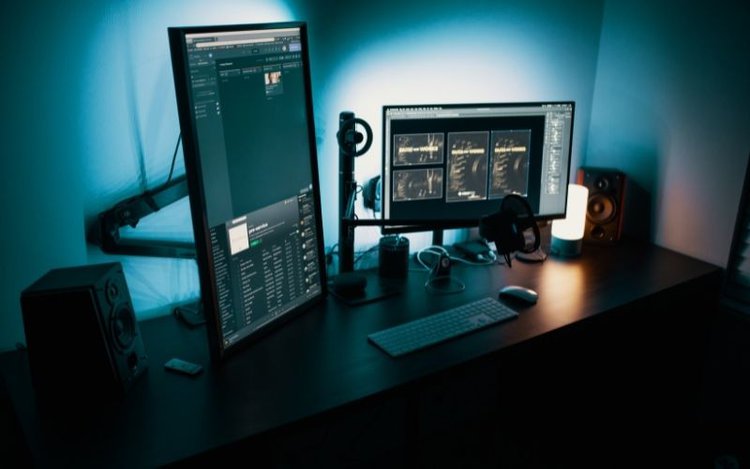
It’s feasible to use an HDMI and DisplayPort, though there are a few things that you need to keep in mind.
Let’s go over what’s needed when simultaneously using HDMI and DisplayPort.
GPU & Motherboard
A weak GPU will already struggle to produce high-quality graphics for one monitor, so it’s essential your GPU is strong enough to handle two.
Luckily, many modern high-quality GPUs do support dual monitors and will clearly state so on their website and packaging.
A weak motherboard will make setting up dual monitors very problematic. So, you must ensure it’s strong enough to handle your monitor’s graphic load.
The higher your monitor’s resolution, the more power your GPU and motherboard need to have. You should ensure your GPU supports the same resolution as your monitor, as not all GPUs support 4K or 8K.
Available Ports
You cannot plug one monitor into your GPU’s HDMI port and the other into your motherboard’s DisplayPort.
Instead, you should ensure you’re using the ports from either the motherboard or GPU, rather than from both.
Here, you have two options:
- Connect both monitors to the GPU’s HDMI and DisplayPort.
- Or, connect both monitors to the motherboard’s HDMI and DisplayPort.
Note: Please avoid using a splitter if your PC does not have the available ports as it will output the same picture for both monitors.
Should I Use DisplayPort Over HDMI?
Whether you should use DisplayPort over HDMI depends on what you plan to use your monitor for.
DisplayPort is mainly used for PC-to-monitor connections, as it supports high resolutions and faster refresh rates.
However, with the invention of HDMI 2.1, HDMI is now on par with DisplayPort’s amazing graphics capabilities.
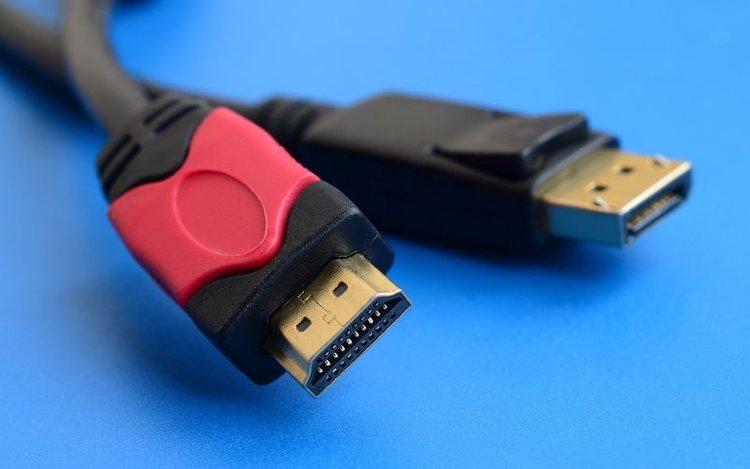
If your computer has an HDMI 2.0 port and a DisplayPort 1.4 or above, it’s probably best to use the DisplayPort, especially if you’re looking to play 4K or 8K games at 120Hz.
However, HDMI is more popular for entertainment systems, like TVs, gaming consoles, audio players, and so on.
Nowadays, these two ports serve similar purposes.
The biggest thing to look out for is which generation of port you’re using and if it supports your monitor’s resolution as well as a fast refresh rate.
DisplayPort and HDMI Comparison Table
The comparison table below maps out the differences between HDMI and DisplayPort generations.
Green indicates that the version supports the given feature, while red indicates that it does not.
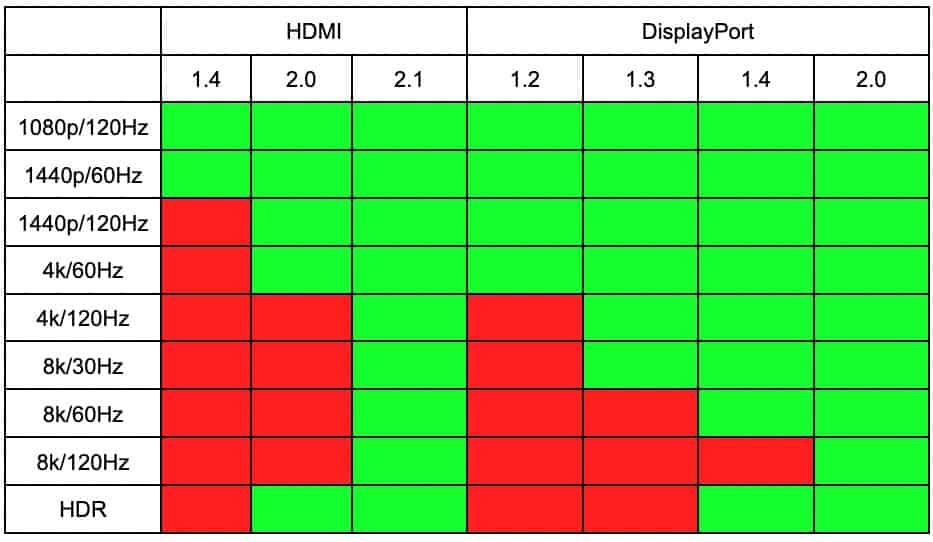
Can I Use a Single Port to Set Up Dual Monitors?
Yes, you can use a single port to set up dual monitors.
So, your PC only has one of each port on both the motherboard and GPU. Now what?
Luckily, you can use your DisplayPort to set up a daisy chain, which will allow you to set up dual monitors with only one output port.
To do this, you will need a DisplayPort 1.2 or above. Follow the steps below to set up dual monitors using a daisy chain.
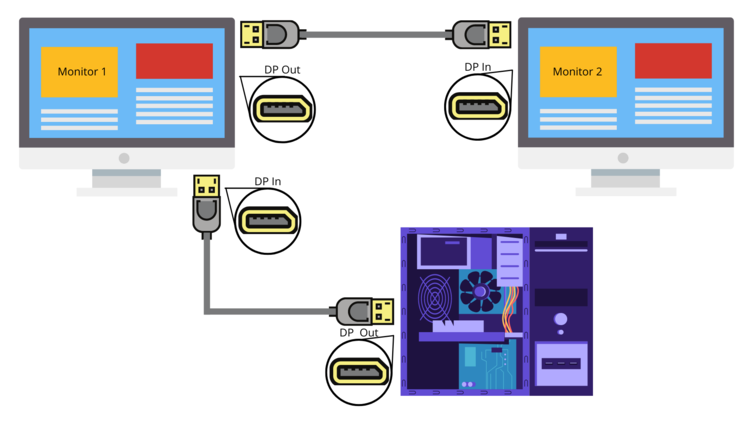
Step 1: Ensure Your GPU Supports DisplayPort v1.2 MST
This process will not be possible if your GPU does not have DisplayPort 1.2 or above, so you must check which generation it has before proceeding to the next steps.
You cannot daisy chain with other output ports, like HDMI or DVI.
Your monitor must also support DisplayPort 1.2. To see which generation of DisplayPort your monitor has, head to its Display Settings.
Ensure DisplayPort 1.2 or above is enabled.
If you find that your GPU does not support DisplayPort 1.2 or above, have no fear. You can download the appropriate driver.
Always be cautious whenever downloading software and ensure you only download content from reputable sites to avoid installing malware or other viruses on your computer.
If you’re interested in downloading the necessary driver onto your GPU, check out the following resources:
Step 2: Connect Your First Monitor to Your Computer
Using a DisplayPort cable, connect the first monitor to your computer’s GPU’s DisplayPort.
Make sure the cable is securely fastened and not being pulled on if your monitor and computer are several feet away from each other. DisplayPort cables have locking mechanisms, so if tugged on, they could break your computer or monitor’s ports.
Step 3: Connect Your Second Monitor to Your First Monitor
Now that your first monitor is connected to your computer, you’re ready to connect your second monitor.
You can use your second monitor’s Mini DisplayPort if it doesn’t have a DisplayPort.
Step 4: Ensure Everything is Working Correctly
Now, you should be able to slide a window from one monitor to the next, allowing you to use them as one large screen.
If you find that your monitors are mirroring the same image, you may need to double-check that your GPU supports DisplayPort 1.2 or above.
You may also need to head to your monitor’s Display Settings and ensure DisplayPort 1.2 is enabled.
If the screen is black, ensure your cables are securely connected, and that both monitors and the computer are all connected to power.
Watch the video below demonstrating how to daisy chain following the steps above.
Wrapping Things Up
HDMI and DisplayPorts can absolutely be used in unison, especially if you’re in a pinch and don’t have two of the same port on your computer.
The most important thing when setting up dual monitors is to ensure your GPU and motherboard are strong enough to power graphics on two monitors.
When connecting the monitors to your computer, remember to only plug them into the motherboard or GPU. Do not plug one monitor into each.
If your computer is a few ports short, do not use a splitter. Instead, try daisy-chaining the monitors, just make sure your GPU supports at least DisplayPort 1.2 MST.
What’s your experience using HDMI and DisplayPort at the same time?
Let us know in the comments below!
Yesenia Achlim is a technical copywriter and editor with a focus on AV equipment. She aims to break down complicated topics and make technology accessible, no matter your technical expertise. When she’s not teaching you how to replace a projector lamp, you can find her reading and baking.


Mine is giving me a really hard time. when I connect the HDMI, the monitor on the display port goes blank (no signal)